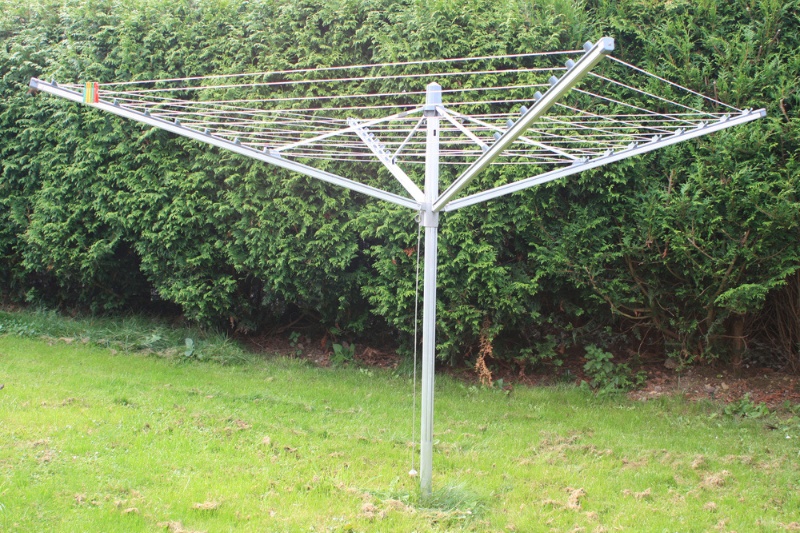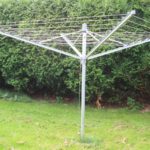Getting a rotary washing line to dry your laundry on is an excellent alternative to using a tumble dryer!
Unlike a tumble dryer, a washing line doesn’t use electricity as you get to make use of the sunlight and the wind, and clothes can last longer and feel better when they’re dried naturally.
But what rotary line do you need to buy? With a massive choice of washing lines on the market, it can be a tad confusing trying to choose what line you need for your home.
When choosing a line, you need to assess how much room you have outside, where you’re planning on putting the line, and how much laundry you wash.
Once you’ve done this, you’ll be able to work out what size rotary washing line you need.
Keep on reading to learn more.
How to Pick the Right Size Rotary Washing Line

When deciding what rotary washing line to buy, there are a number of factors you need to keep in mind because they will directly influence what size line you’ll purchase.
The points you need to consider are:
- How much space do you have available?
- Location of the rotary washing line.
- How much washing do you do?
Let’s take a look at each of these points in more detail.
How much space do you have available?
One of the main factors you must consider when getting a washing line is; do you have space in your garden for a rotary washing line?
A rotary washing line is typically placed into a solid socket that’s been fixed into the ground.
Once the line has been secured in place, the arms on the line lift up, and you can peg your clothes on the taut lines that run between the arms.
First and foremost, you need to find a suitable area where you can securely put the washing line’s socket into the ground. The socket will typically need to be cemented or screwed into place.
It’s possible to fit a washing line socket yourself, but depending on what type of ground you have in the garden it can be tricky. You’ll likely have to dig up some grass/move some slabs around and level the area, so you can put the ground socket safely into the ground.
You need to make sure that a socket can be fitted properly, otherwise the rotary line will be wonky and wobbly when you fit it into the socket. This, in turn, can put needless strain on the pole and can break the line in the long term.
Once you’ve decided where you’d like to put the line, you’ll then need to measure the available space in this area (the turning circle).
You must have enough space to accommodate your washing line when its arms are outstretched.
You need to be able to open the line up without it causing any damage to itself or to anything around it. There’s no point putting your rotary line next to a wall, for example!
Rotary washing lines when opened up can be rather cumbersome, and ideally, they need to have about two metres of space around them.
In some cases, you might need a bigger turning circle of three metres. But this figure does fluctuate between washing lines.
If you’ve not got a suitable spot to pop your ground socket in, or the line you’d like to buy would be too big, you need to consider getting a smaller one.
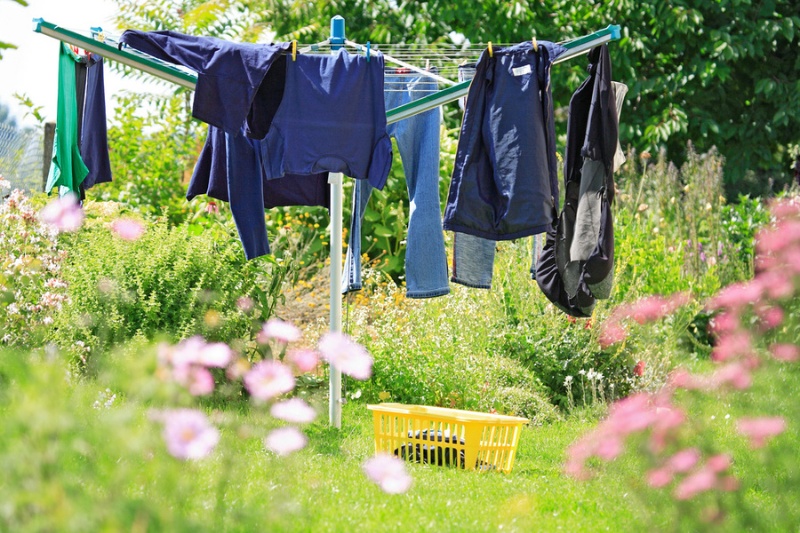
Or perhaps you should look into other washing lines that may be more suitable for your garden, like wall mounted lines, or a line that goes between two washing posts.
In addition to this, it’s also worth considering whether or not your laundry will have enough blowing room. You should have about an additional metre around your line for ‘blowing space’.
For example, if you were drying large sheets, you’d need space for the sheets to blow up and around. You wouldn’t want them getting tangled on a branch!
If your laundry can reach out and get caught on things as they blow in the wind, you might find that your line doesn’t rotate as it should, the laundry could get damaged, or in extreme circumstances, it could put unnecessary pressure on the line and break it.
Space is key! So, if you have to choose a smaller washing line to work within the space you have, do so. There’s no point buying an extra-large line, if you can’t use it effectively.
Location of the rotary washing line
As a follow on from the point above, you’ll need to think about where you get the most sun and best breeze in your garden. Wherever this is, is the ideal location to put your rotary line.
What you might come to realise is that the ‘best spot’ may not be a big one. So, you might have to purchase a smaller line that fits into the area, so you can make the most of the weather, and vice versa.
For example, if you get a lot of sun in one spot in the garden, but you haven’t got enough room for a large 60 metre rotary line, it would be better to get a smaller line. You could make the most out of sunlight by doing this. Plus, this would speed up your drying time considerably.
How much washing do you do?
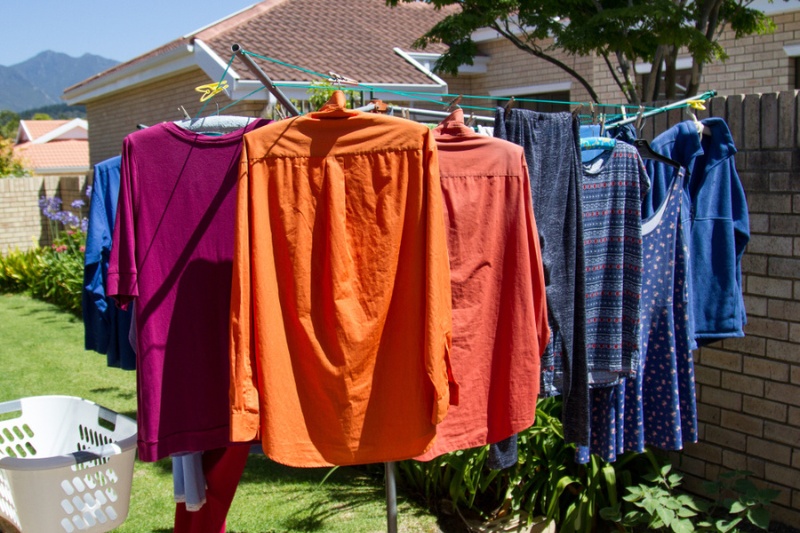
Another significant factor that you must consider is how much laundry you do.
If you don’t do a huge amount of washing per day, you may not need a very big washing line.
A rotary line with three arms and 30 metres of drying space would be ideal. The Brabantia 30 Metre 3 Arm Compact Rotary Washing Line would be suitable in this case.
On the other hand, if you’ve got a large family, say parents and two or three children, you might do more washing, and would need a bigger washing line.
A washing line with 60 metres of space, like the Vileda 60 Meter Super Dry Hoist Rotary Airer would be more suitable, as this would hold more loads of laundry, up to five to be precise.
Other Factors to Consider When Choosing a Rotary Washing Line
Of course, size is one major factor to think about when choosing a rotary washing line. However, there are a few other things you ought to consider before you commit to buying a line.
Can the rotary line fold down?
Most washing lines can be collapsed, so they become much smaller in size. This is particularly helpful if you need to pull the line down in bad weather, or if you want to remove the line from the ground and store it.
It’s not essential, but it is a beneficial feature to have.
Is the washing line’s height adjustable?
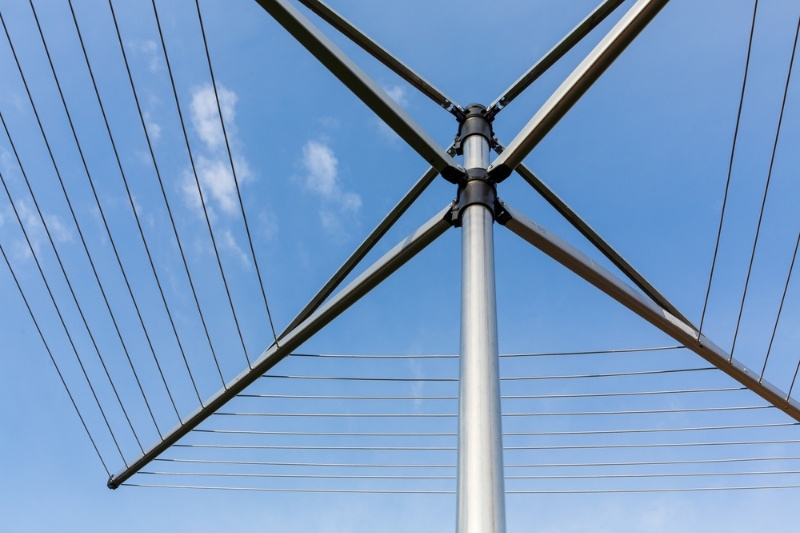
You can usually adjust the height of most rotary lines by pushing the centre piece upwards, or by turning the hand crank.
Ideally you should pick a washing line that is suitable for your height, and for what laundry you need to dry.
There’s no point buying a line that you can’t reach properly. Similarly, you need a line that’s tall enough (or can be adjusted), so your washing won’t drag along the floor.
Most washing lines will fit somewhere along this height scale: between 130 cm to 190 cm approx.
Can your rotary washing line grow with you?
If you take care of your washing line, there’s no reason why you’ll need to buy a new one regularly. So, it’s worth thinking about the future when you buy a rotary line.
If you’ve got ample room in your back garden, and in the future a relative might move in or your family may grow, it might be worth thinking about getting a line that could accommodate such big life changes. It could save you some money in the long run.
Do you get a cover with the washing line?
Although it’s not essential to cover your rotary washing line, popping a cover over your line can protect it from the elements. In turn, your line may stick around for longer!
Some rotary lines come with a cover as part of a deal, but in other cases you’ll have to buy one yourself. Just make sure you pick the right size cover.
How much does the rotary line cost?
Very basic rotary washing lines can cost as little as £20-£30 in some shops.
They’re generally not massive in size and they don’t usually come with any extras! But they’re normally solid enough, and if looked after well, they can last a long time.
On the other end of the scale, you can pay upwards of £100 for a rotary washing line!
These lines are usually bigger (more drying space), sturdier, come with better features like a handle to crank the line up and hanger hooks) and come with extras (cover/pegs), and in some cases, guarantees.
In addition to this, if you’re going to go with a well-known brand, like Brabantia or Vileda, you’re likely to pay more for the expertise and exceptional build quality of the lines.
Is there a special hoist mechanism on the rotary line?
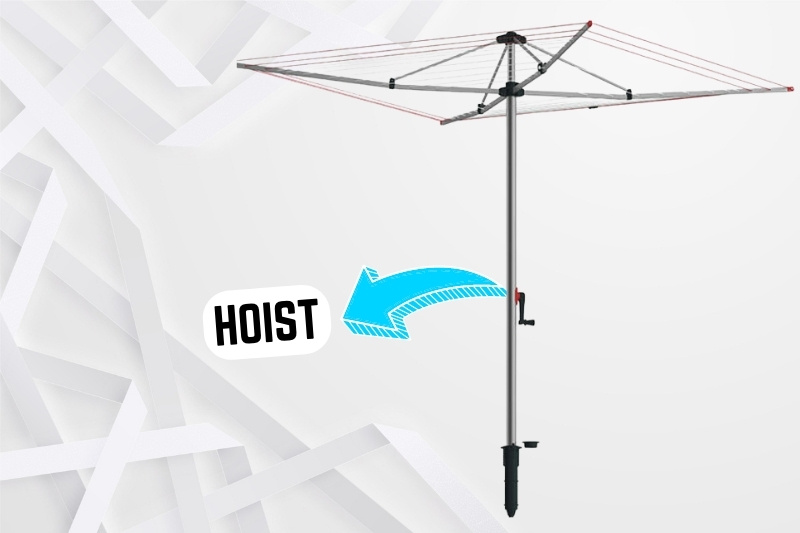
An interesting feature to have on a rotary washing line is a crank feature.
This is where you have a little handle on the central pole, and you turn it to lift the arms of the washing line. It’s basically the same mechanism as you get on most outdoor umbrellas!
Of course, this isn’t an essential feature to have. But it can be quite handy if you find it difficult to push the centre of your line upwards to open the arms.
The handle feature is also helpful if you need to pop the line up and down quickly! There’s no fuss, you just turn the handle and you’re done.
The Vileda 60 Metre Super Dry Hoist Rotary Airer comes with a crank handle, and users frequently note how easy it is to open/close the line.
How Long Do Rotary Washing Lines Last?
Rotary washing lines, if looked after correctly, can last a very long time! It’s not unheard of for some washing lines to last over 10 years.
A washing line that is made of sturdy materials, covered and stored when not in use, and repaired when necessary, should be able to last a very long time.
Of course, if you leave your washing line out in the elements and you don’t cover it, you may notice that the washing pole starts to break down, and the washing lines may become saggy/broken. In turn, the lines will lose their tension and won’t hold your laundry up properly.

Bethan has a passion for exploring, reading, cooking and gardening! When she’s not creating culinary delights for her family, she’s concocting potions to keep her house clean!
